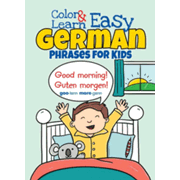Brilliant! Foreign Languages, a company new to the homeschool market, produced their first courses to teach the German language. Geistreich! [“brilliant” in English] German Level 1 is best for children in grades one through three. German Level 2 takes students up through fourth grade. You can easily stretch to include younger and older students as well. Subsequently, they have begun publishing these same courses in versions for learning Spanish and Italian. According to the publisher, as of May 2021, Italian 1 has the textbook, workbook, and CD available. Spanish 1 has the textbook and CD available, and the workbook should be finished by the fall of 2021. I reviewed only the first course for German for this review.
Brilliant! Foreign Languages takes an unusual approach wherein students ideally start German Level 1 in first grade then progress to German Level 2 in second grade. You will use the Level 1 and Level 2 textbooks for these two years, plus the pronunciation audio CD for each course as needed. For the third and fourth grades, you will cycle through Levels 1 and 2 again, reviewing the vocabulary and adding a workbook. No reading or writing is required for first and second graders since children are learning to read and write English. The addition of reading and writing German words in third and fourth grade makes recycling through the same text almost like an entirely different experience.
Courses are written for homeschooling families. Lessons introduce new vocabulary then instruct parents to try to use the words, phrases, and sentences throughout the day. The lessons themselves are fairly brief. For example, Unit (or lesson) 34 on household objects says, “Read through the list several times then go around the house and name objects that you find. If you would like, label some household objects so you can remember and help your student practice throughout the week (and year!).” This is followed by a two-column list of objects such as window, television, sink, and bed, with German on the left and English on the right. It's up to you to provide the labels and direct the practice. While this demands more from parents, it is probably much more effective for children than most other methods of learning.
While there is a pronunciation guide on two pages at the beginning of the book, there are no phonetic pronunciations shown in the textbook. Parents who already have some familiarity with German pronunciation should have no problem, but those new to German are likely to find this cumbersome. Parents should listen to the pronunciation on the audio CD, but reminders within the text would have been helpful.
The textbook is a half-page size book with a wire binding that allows the book to like completely flat. It is intended for the parent to use the textbook, for the most part, reading lessons directly to students then practicing with them. Occasional pages instruct parents to make a copy of a page for students to use. (This is where the lie-flat design of the text comes in very handy.)
An audio CD comes with the textbook. The audio CD features native German speakers pronouncing new vocabulary or lesson content for each lesson. They speak at what seems a normal pace, but this might be a little too fast for those trying to grasp a new language. For me, it helps to look at the words in the text as I listen to the pronunciation. However, you will be using only a conversational approach with non-readers. This means that you probably need to practice the new vocabulary in advance so that you can help your children practice it.
There are 96 units (lessons) in Level 1. The plan is for you to teach three lessons per week. The third lesson for each week reviews what was taught in the previous two lessons. Each quarter concludes with three lessons that comprise a “review week.” At the end of the course, the review stretches out to ten lessons. Thus, a certain amount of review is built into the course. If you are practicing German casually with your children as the course intends, other repetition and review will be taking place all the time.
Three weeks of lessons within the course are designed as easy weeks. You can use these whenever you need to lighten the schedule. These lessons teach nursery rhymes and songs in German. For instance, one week teaches only “Baa, Baa Black Sheep” in German. Children will listen to the audio CD then practice repeating the nursery rhyme. As you might have surmised, this will probably require listening to the CD track many times, but parents do not need to teach it.
The Level 1 Workbook must be used in tandem with the textbook, and each student (third grade or older) needs his or her own book. Students should be able to look up things in the textbook if need be. There is one workbook page for each lesson, but the activities vary greatly from page to page. Some are fill-in-the-blanks questions with most of the responses to be written in German. Sometimes children will write complete sentences. Other activities require drawing, filling in missing letters, circling the correct answer, completing word search or crossword puzzles, and coloring. There is even a page with a math problem that requires children to write the German words for the numbers involved. Many workbook pages have full-color illustrations. The answer key comes as four pages stapled together.
You can purchase the bundle that includes the textbook with the audio CD and the workbook, or you can purchase items individually.
As a supplemental item, the Brilliant! Foreign Languages website recommends a coloring book that I think should be very helpful for both parents and children, Color & Learn Easy German Phrases for Kids. This inexpensive, 60-page coloring book includes phonetic pronunciation assistance for German vocabulary words and covers some of the same vocabulary taught in Level 1.
I expect that Geistreich! German courses, as well as those for Italian and Spanish, will appeal most to parents who already have some familiarity with the new language to be learned and are looking for some guidance as to how to teach it to their children. Parents new to the language might find it difficult to keep ahead of their children since they need to learn the pronunciation and direct oral practice with their children at the same time. On the other hand, modeling learning right alongside one's children can be an excellent way to learn for both parents and children.









